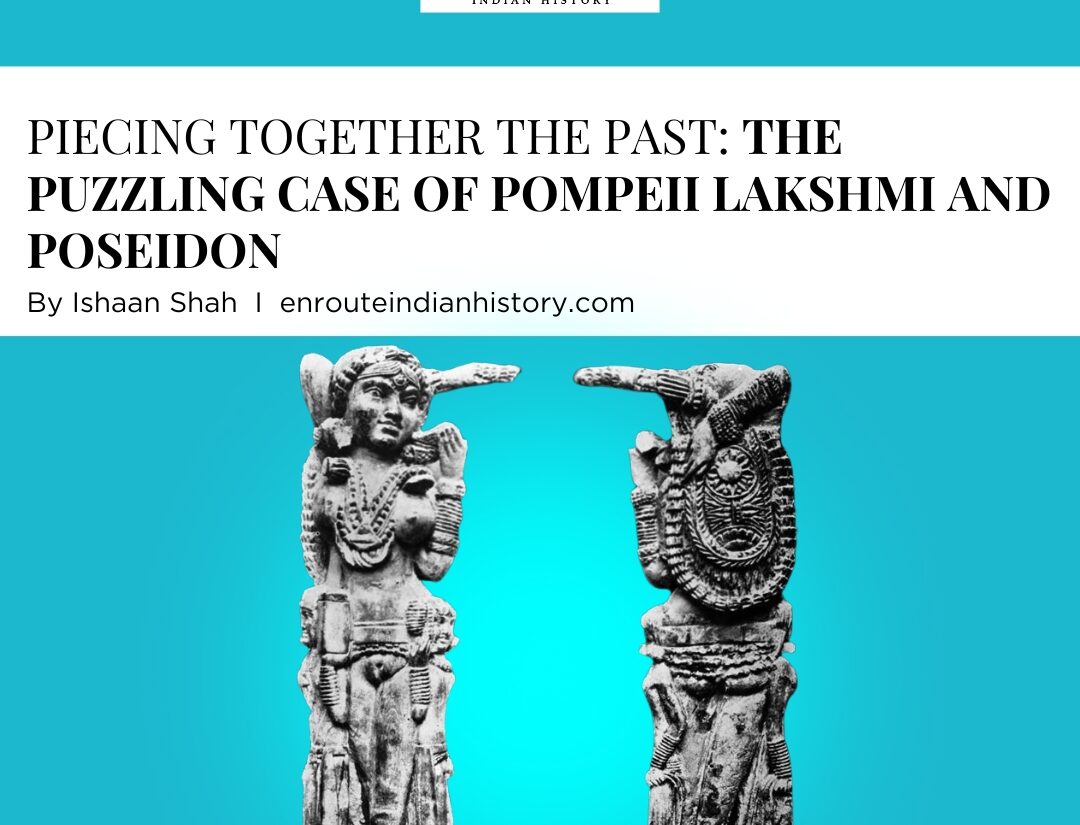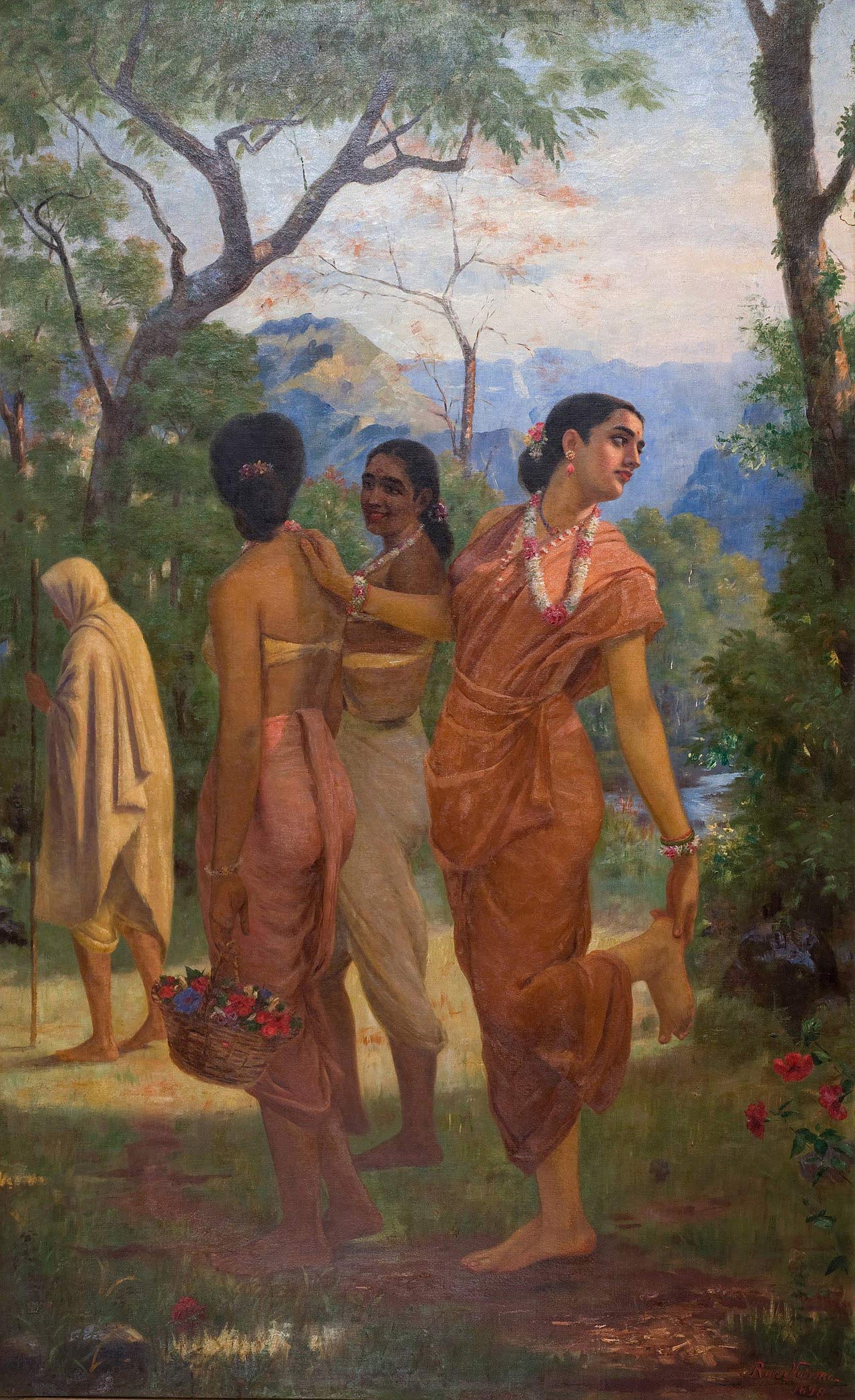Piecing Together the Past- The Puzzling Case of Pompeii Lakshmi and Poseidon
- enrouteI
- June 19, 2024

Archaeological excavations are filled with interesting discoveries and surprise finds, that spark curiosity and excitement for future study and debate. Two such discoveries in two different countries, found in the early 20th century and dating back to the first century CE, which is the Poseidon statuette from Kolhapur, Maharashtra, and the Pompeii Lakshmi statuette from Pompeii, Italy are puzzling and aid in the collective understanding of the Indo-Roman trade excavations in the ancient period.
The early twentieth century brought out a wave of curiosity and interest in history and archaeological circles when Poseidon was excavated in Kolhapur, a bronze statuette of the ancient Greek God, in Kolhapur, Maharashtra. This was, however, a few years later when in the Italian city of Pompeii an ivory statuette of the Indian Goddess, Lakshmi, was found in 1938. These two findings bring forth the foreign relations that existed during the ancient times between the Roman Empire and India. Kolhapur in southern Maharashtra was ruled by the Satvahanas. They captured most parts of today’s Southern Maharashtra by 78 CE. This dynasty controlled most of Western India and North Deccan at the turn of the Common Era. Pompeii was a flourishing city south of the ancient Roman Empire. The city was nestled along the Italian coast in the shadow of Mount Vesuvius, an active volcano that erupted in 79 CE, burying the Roman city under volcanic ash. These two amazing artifacts reflect one of the most puzzling and exciting Indo-Roman archaeological discoveries. The two statuettes stand as a testament to the flourishing ancient economic links between the Empires of the West and the East. These links between the Satvahanas and the Romans also seemingly depict the exchange of ideas between the two Worlds, as the two statuettes are religious figures that boast 2,000 years old rich iconography, more in the case of the Pompeii ‘Lakshmi’.
POMPEII POSEIDON DISCOVERIES- ‘POMPEII LAKSHMI’
The disastrous eruption of Mount Vesuvius in 79 CE was a big blow to the city of Pompeii which was one of the prosperous outlets of trade of the Roman civilization. This site was entirely obscured when it was rediscovered in 1599 and then in 1748 by a Spanish Engineer Rocque Joaquin de Alcubierre. Italian scholar and archaeologist Amedeo Maiuri excavated the figure of ‘Pompeii Lakshmi’ in 1938. This figurine was found when the team was excavating around Casa dei Quattro Stili. The statuette was recovered from a house situated next to a dye house. The figure is almost entirely nude, but she is adorned heavily with jewelry such as necklaces, bangles, head ornament, and elaborate coiffure. Being at a height of 25 cm and 5 cm wide, she is supported by two attendants on either side. A hole on top of the figure suggests its relation to a larger object. The figure could be a fertility goddess or yakshi, as the genitals are visible. Scholars have argued that this statuette could be a syncretic form of Indo-Roman goddesses- Sri, Lakshmi, and Venus. The latter is attributed to the fact that many Venus goddesses in the Roman world would show her being accompanied by two attendants. The representation of the lotus has made the figurine to be associated with Goddess Lakshmi, but some scholars suggest that the ornaments of the figurine would have been intended as a symbol of beauty, rather than a mark of a Goddess or a yakshi.

(Source- Mediterraneo Antico, Italian archaeologist Amedeo Maiuri)
Its source is widely believed to have been from Bhokardan in Maharashtra, which used to come under the rule of the Satvahanas. This is attributed to similar figures found by archaeologists there. The figure is marked with an inscription in Kharosthi at the bottom that suggests its sourcing from the northwestern regions, probably Gandhara in present-day Pakistan or Begram in present-day Afghanistan. The latter was a major center for the production of carved ivories and these ivories from the Kushana period, found between 1936 and 1940, are similar to the figurine found in Pompeii. Some also feel that the figurine was

Studio/July,49,A05cGODDESS OF LOVEIndian ivory figure found at Pompei. Early 1st century.
(Source- Wikimedia Commons, Pompeii Lakshmi– front and back)
made in the Indian subcontinent due to its similarities with the Mathura school and examples of Bharhut yakshi and some at Sanchi. It can be inferred that all these centres interacted with
each other thus the origin of the figurine cannot be attributed to a single center, but rather a mixture of all these. It is assumed that the figure was made in the early half of the first century CE and was brought to Pompeii via the port of Bhrigukaccha or present-day Bharuch. The house, where the figurine was found, is now named “The House of the Indian Statuette”, however, the figurine is now displayed at the National Archaeological Museum in Naples, Italy. It was not until, however, a few years later the Pompeii Lakshmi archaeological finding that a discovery of a Roman God in Kolhapur, Maharashtra would create links with the ivory statuette.
POMPEII POSEIDON DISCOVERIES- KOLHAPUR’S POSEIDON
The statuette of Poseidon was excavated in 1945-46 by archaeologist H D Sankalia on Brahamapuri hill, on the banks of the Panchganga River in Kolhapur, Maharashtra. It represents one of the most refined versions of Greco-Roman art found in Asia. The figure was excavated 3 meters below the remains of an ancient house, believed to have been of a seafaring trader. It is over 13 centimeters tall and made waves among scholars.

(Source- Wikimedia Commons, Archaeologist HD Sankhalia)
The statuette was discovered along with other artifacts, called the Brahampuri Hoard. Forming an important fact of the Roman artifacts in India, this hoard contained imported Roman bronzes and other Indian artifacts. In addition to this, lead coins dating to the
Satvahana era was found in two large-sized bronze pots, found in a house close to a well. The Roman bronzes include an emblema or a raised panel depicting figures,

(Source- X.com, Kolhapur’s Poseidon)
showing the legend of Perseus and Andromeda, a jug, and a jug’s handle, apart from the statuette of Poseidon. The latter was the Greek God of the rivers and the seas, the creator of floods and storms, and the bringer of destruction in the form of earthquakes. He was probably the most destructive and disruptive of all the ancient deities.
However, the excavated deity doesn’t seem to be vigorous or aggressive and is believed to have been originally from Alexandria. It is interesting to think how this reaches India and that to the south of Maharashtra. Since Poseidon is the god of the sea, people feared him for his destructive tendencies and therefore worshipped him- for this reason, a trader who was entangled in the prosperous ancient Indo-Roman trade route, carried an idol of the Roman deity, showcasing how religion dominated one’s course of vocation. Displayed now at the Town Hall Museum in Kolhapur, this excavated figurine, lying for around 2,000 years is a testament to the connections that both the Worlds enjoyed between each other, between people and empires, encapsulating interactions, dialogues, and transactions.
INDO-ROMAN TRADE LINKS
The ascendence of Augustus on the Roman throne and his annexation of Egypt around the start of the Common Era boosted the Indo-Roman trade which thrived and flourished. Even though trade took place via land routes, Augustus is credited with establishing safe contact over the open sea with India, where the trader would leave Aden to arrive in India in September. They spent two months here and used the November winds to return from Egypt. This system reduced the number of shipwrecks. By this time, Indian kingdoms had a well-laid-out system to enable this trade link with customs officers, taxes levied and spies settled. As mentioned earlier, Satvahanas ruled during this time in the Northern Deccan and most parts of Western India. They ruled present-day Kolhapur in Southern Maharashtra and this expansion helped spread the Roman trade network whichever territories they conquered. The Satvahanas not only controlled ancient Indo-Roman trade routes on the west coast but also in the hinterland as well in 20 CE, Hippalus, a Greek sailor discovered that ships could now sail Egypt to India directly with the help of strong monsoon winds.
As for Satvahanas and Roman trade, Roman ships would dock regularly at ports such as Chaul in the North Konkan, north of Mumbai, Maharashtra, filled with commodities like precious stones, metals, wine, and ivory. These ships would then return with spices, bangles, textiles, salt, and grains. Brahampuri in Kolhapur falls on the trade route that linked the ports of Konkan with the cities in the Deccan and the Poseidon was likely brought by a Roman trader or was bought by an Indian trader as a souvenir who brought it home. Interestingly, Rome also brought Indian wildlife- tigers, serpents, elephants, and rhinoceros to entertain the Roman crowd in circus shows. Indian pearls were adored by the Roman women, as Pliny the Elder writes. Romans also bought Indian incense, wood, ebony, and indigo and the spices they bought from India included sugar, pepper, and sesame oil.

Software: Microsoft Office
(Source- World History Encyclopedia, Periplus of the Erythraean Sea Map)
The Indo-Roman trade was a thriving economic activity for the Indians that made Pliny write that India, Arabian Peninsula, and China ‘take one hundred million sesterces from our empire per annum at a conservative estimate: that is what our luxuries and women cost us.’ Apart from perfumes, glassware, and silverware, the Romans traded the Mediterranean red coral with Indians, which the Indian seers believe, as Pliny the Elder tells, that ‘coral as a charm for warding off dangers. Accordingly, the delight in its beauty and religious power.’
Even though the earliest evidence of this thriving commercial relations between ancient India and Rome comes from the southern Peninsula, from Kerala, Roman artifacts in India also include Roman amphorae that were excavated from Ter in Maharashtra Bharuch or Bhrgukachcha in Gujarat was also an important Indo-Roman trading port. The port traded inland with Pratisthana or Paithan and Tagara or Ter (both in Maharashtra). The Periplus of the Erythraean Sea, an ancient mariner map of the Indian Ocean World, mentions two ports- Kalyana and Sopara as very important for Indo-Roman trade. The source also lists other ports such as Chemula or Chaul, Mandragora or Mandad, Palaepatmae or Dabhol, Melizigara or Jaigarh, Tosarum or Deogarh and Arranoboas or Malvan, all situated on the western coast of the subcontinent.
As for the southern peninsula, Roman artifacts were found such as coins, glass fragments, amphorae, and bead-manufacturing industrial objects at Pattanam, which was considered to be the region of the Muziris. Other sites that were Indo-Roman trading ports are Madurai(for its pearl fisheries), Kaveripattanama or Puhar (where the Yavanas had their colonies), Poduca or Pondicherry, Sopatma, and Arikamedu. The thriving trading relations led to the growth of various Buddhist monasteries in western Maharashtra. Most of these such as the Karle Caves were located along trading routes and received donations from foreign and Indian merchants. Trading interactions and contacts could be reflected in these caves too when Sphinx and Griffins sculptures are seen. Kanheri and Nasik also boast a carving of a double-humped Bactrian camel, which is not native to the subcontinent. Furthermore, Buddhist monasteries at Ajanta and Pitalkhora were established at the crossroads of important commercial outposts linking the cotton-producing regions of the Deccan to different distribution centers such as Bharuch, Ujjain, Kalyan, and Sopara.
Ancient trading networks were also centered on the distribution of cotton textiles in the Western Deccan, across the Indian Ocean. The Periplus of the Erythraean Sea mentions a variety of cotton textiles produced at Paithan and Ter for trade across the Ocean. This is corroborated by archaeological evidence with the finding of the 1st CE Indian cotton fragments in Egypt’s Red Sea Port of Berenike.
The importance of maritime trade contacts with the Roman world is reflected in the coins of Satvahana ruler Yajnasri Satakarni, where a large ship has been depicted. A ship with a double mast is also depicted on the coin of Satvahana king Vasishthiputra Pulumavi.

(Source- Peepul Tree Stories, Coin of Satvahana King Vasishthiputra Pulumavi)
However, these trade relations slowly declined towards the 4th and 5th centuries CE due to political upheavals in India and the Roman world. These Indo-Roman trade excavations including the Roman hoard and the statuettes of Lakshmi and Poseidon from Pompeii and Kolhapur respectively point to a great inland trade between India and Rome. The finding of such artifacts points not only to a thriving business along the southern coast but also to a prosperous interaction along the western coast that had connections inland as well.
INDO-ITALIAN RELATIONSHIP
It is undeniably a fact attributed to the excavations of these two statuettes that Indo-Roman trade and its overseas connection led to active import and export business, along various trading routes. This was the ancient connection that the two countries enjoyed. In the present context too, India and Italy enjoy a strategic relationship, where India exports organic basic products precious metals, textile products, fish, dyes and pigments, motor vehicles, etc. Italy also exports items like machinery for leather, garment, textiles, general-purpose machinery, chalk, slate, gypsum, etc to India. The very recent G7 Summit was held in Apulia, Italy, where the two leaders strengthened their economic relations and cooperation in multilateral initiatives such as the India- Middle East- Europe Economic Corridor- this initiative looks forward to a vast road, shipping network and railroad among India, the USA, Saudi Arabia, and Europe for better integration among Asia, the Middle East, and the West (a modern trade route!) The leaders also called for the expansion of commercial relations in Space, Science and Technology, clean energy, manufacturing, AI, telecom, and minerals to build supply chains.
Whether it is the 2,000 years old relation between Poseidon or Pompeii Lakshmi, attributed to a thriving network of ideas, people, and commodities between India and Rome, along ancient Indo-Roman trade routes or it is the strategic economic and commercial ties and diplomatic exchanges between the two democratic nations of India and Italy, it is, without doubt, that Indo-Roman trading relations have survived the brunt of time and have been flourishing since the ancient times. These Indo-Roman archaeological discoveries of the early twentieth century have altered one’s understanding of their relations, considering trading inland as well, under the patronage of the Satvahanas. It is only with profound admiration for their international relations that one can attempt to appreciate an active cross-cultural exchange, visible to the people now in the form of these two beautiful statuettes, perhaps a product of their exchange of ideas or as a souvenir given to a Roman or an Indian trader!
REFERENCES AND BIBLIOGRAPHY
https://www.peepultree.world/livehistoryindia/story/eras/kolhapur-poseidon
https://www.peepultree.world/livehistoryindia/story/people/satavahanas-yavanas-and-the-cotton-road
https://www.indica.today/long-reads/ancient-indian-economy-indo-roman-trade-paradigm-indic-history/
https://www.peepultree.world/livehistoryindia/story/art-history/the-mystery-of-pompeii-lakshmi
https://indianembassyrome.gov.in/page/india-italy-political-relations/
https://mapacademy.io/article/pompeii-lakshmi/
https://www.thebetterindia.com/155431/news-india-pompeii-lakshmi-roman-empire-link/#google_vignette
https://www.worldhistory.org/poseidon/
IMAGE REFERENCES
https://commons.wikimedia.org/wiki/File:Pompei_Indian_Statuette_front_and_back.jpg
https://www.worldhistory.org/image/14390/periplus-of-the-erythreaen-sea/
https://x.com/vicitracitta/status/1710508105749200997
https://commons.wikimedia.org/wiki/File:H.D.Sankalia.jpg
https://mediterraneoantico.it/articoli/archeologia-classica/amedeo-maiuri-vita-larcheologia/




















